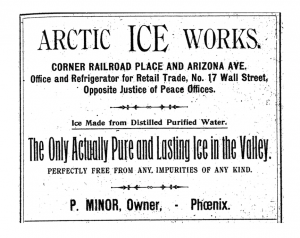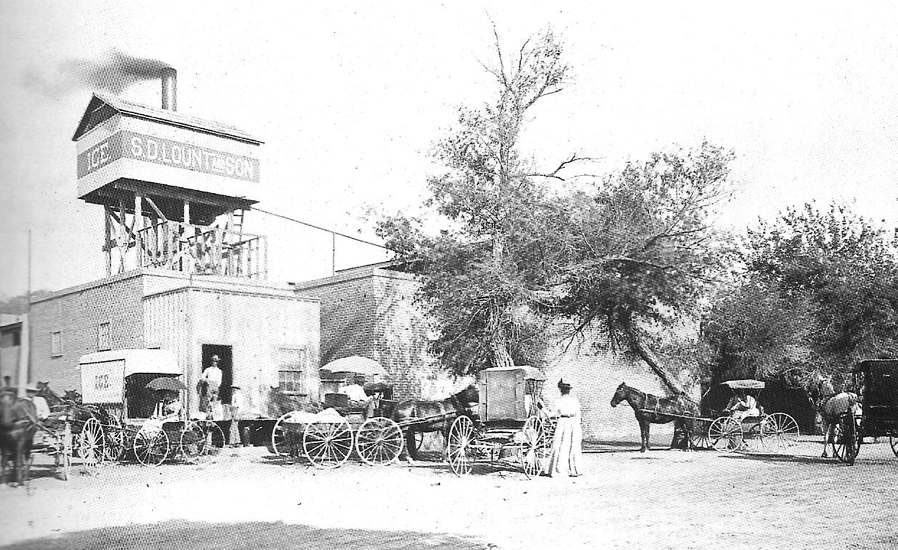On Ice
Did you know…
At the turn of the century, Phoenix was home to two “ice works” — factories that produced, sold and delivered ice — Arctic Ice Works, and the Phoenix Ice Factory, both located fairly close to the Rosson House.  Arctic Ice Works (owned by P. Minor) was located just north of the train tracks, and just east of what is now Chase Field. The Phoenix Ice Factory (owned by S. D. Lount and Sons) was located about where the Phoenix Convention Center is today, at 4th Street and Washington. You can check out their location, and a lot of other cool stuff, on the 1893 Sanborn Fire Insurance Maps of Phoenix at this link. But the real question is, how on earth did they make ice in the Victorian era?? It turns out, much the same way we do today.
Arctic Ice Works (owned by P. Minor) was located just north of the train tracks, and just east of what is now Chase Field. The Phoenix Ice Factory (owned by S. D. Lount and Sons) was located about where the Phoenix Convention Center is today, at 4th Street and Washington. You can check out their location, and a lot of other cool stuff, on the 1893 Sanborn Fire Insurance Maps of Phoenix at this link. But the real question is, how on earth did they make ice in the Victorian era?? It turns out, much the same way we do today.
Ice is made in our freezers by running some form of refrigerant (usually freon) through pipes, cooling water to the point of freezing. Victorians did the same thing in their factories, although they used liquefied ammonia or sulfurous oxide instead of freon. You can find out more about the process from the May 1891 edition of Popular Science, here.

Ice box refrigerator from the 1908 Sears Roebuck catalog.
And how long would that ice last? Much of that depends on what kind of ice box refrigerator you had (and how much ice it held), where it was kept, how close your house may have been to the factory (Rosson House definitely had an edge there!), and most importantly, how hot it was outside. More ice would definitely be used in the summer months instead of winter months!
Opening the pages of a Sears Roebuck catalog from that era gives you an idea of what ice boxes looked like, including size, ice and grocery storage capacity, and sometimes what they are insulated with. Obviously, an ice box that was kept in a cellar, or in a room that received less direct sunlight would keep ice frozen longer. We did our own science/history experiment at Heritage Square with a block of ice two summers ago, and found that it takes a 10 lb. block of ice (in an open cooler on the back porch of the Rosson House, on a 110° day in late June) 22 hours to melt. Yes, you read that right — 22 hours! The reason a 10 lb. block of ice last longer than your 10 lb. bag of ice from the store is because the block has less surface area, and therefore less of the hot air can touch it. The Rosson House currently has an ice box that can hold a 25 lb. block of ice, though many ice boxes held a 50 lb. block or more. Those blocks would definitely last longer, but still wouldn’t have the cooling power our refrigerators do today.
(Ice ads pictured above are from the 1895 Phoenix Directory)
Archive
-
2024
-
April (1)
-
March (1)
-
February (1)
-
January (1)
-
-
2023
-
December (1)
-
November (1)
-
October (1)
-
September (1)
-
August (1)
-
July (1)
-
June (1)
-
May (1)
-
April (1)
-
March (1)
-
February (1)
-
January (1)
-
-
2022
-
December (1)
-
November (1)
-
October (1)
-
September (1)
-
August (1)
-
July (1)
-
June (1)
-
May (1)
-
April (1)
-
-
2021
-
December (1)
-
November (1)
-
October (1)
-
September (1)
-
August (1)
-
July (1)
-
June (1)
-
May (1)
-
April (1)
-
March (1)
-
February (1)
-
January (1)
-
-
2020
-
December (1)
-
November (1)
-
October (1)
-
September (1)
-
August (1)
-
July (1)
-
June (1)
-
May (1)
-
April (1)
-
March (1)
-
February (1)
-
January (1)
-
-
2019
-
December (1)
-
November (1)
-
October (1)
-
September (1)
-
August (1)
-
July (1)
-
June (1)
-
May (1)
-
April (1)
-
March (1)
-
February (1)
-
January (1)
-
-
2018
-
December (1)
-
November (1)
-
October (1)
-
September (1)
-
August (1)
-
July (1)
-
May (1)
-
April (1)
-
March (1)
-
February (1)
-
January (1)
-
-
2017
-
December (1)
-
November (1)
-
October (1)
-
September (1)
-
August (1)
-
July (1)
-
June (1)
-
May (1)
-
April (1)
-
March (1)
-
February (1)
-
January (1)
-
-
2016
-
December (1)
-
-
2015
-
May (1)
-
January (1)
-
-
2014
-
July (1)
-
